Two-year follow-up of exposure and imipramine treatment of agoraphobia
Abstract
Sixty-two agoraphobic patient who had completed a controlled study of therapist-assisted in vivo exposure (flooding) and imipramine were assessed 1 month, 6 months, 1 year, and 2 years later. Overall, improvement during treatment was maintained throughout follow-up. At 1 month but not subsequently, imipramine and flooding had significant effects on central measures of agoraphobia. Patients who were marked treatment responders had a favorable clinical course and did not experience secondary depression, unlike patients who had not responded markedly to treatment. These findings suggest that treatments which evoke maximum therapeutic benefit initially are likely to foster long- term maintenance and reduce subsequent depressive sequelae.
Access content
To read the fulltext, please use one of the options below to sign in or purchase access.- Personal login
- Institutional Login
- Sign in via OpenAthens
- Register for access
-
Please login/register if you wish to pair your device and check access availability.
Not a subscriber?
PsychiatryOnline subscription options offer access to the DSM-5 library, books, journals, CME, and patient resources. This all-in-one virtual library provides psychiatrists and mental health professionals with key resources for diagnosis, treatment, research, and professional development.
Need more help? PsychiatryOnline Customer Service may be reached by emailing [email protected] or by calling 800-368-5777 (in the U.S.) or 703-907-7322 (outside the U.S.).



